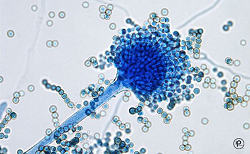Lecture Overview
In his first lecture, Dustin explains that adaptive immunity allows an individual to specifically recognize and respond to a vast number of molecules. B cells recognize intact antigens and produce neutralizing antibodies. T cells, on the other hand, have receptors on their surface that recognize very small antigen fragments bound to MHC on the surface of antigen presenting cells (APC). Dustin explains that T cells overcome the challenges of finding and binding to the APCs with the help of a multitude of adhesion molecules. Once the T cell receptor has bound a peptide antigen, an immunological synapse, with its typical bulls-eye structure, is formed resulting in T cell activation.
In Part 2, Dustin describes how a reconstituted system has allowed the immunological synapse to be studied in molecular detail. It is possible to visualize the localization of signaling molecules such as kinases, and determine the role of the actin cytoskeleton in regulating this localization. Dustin also touches on the role of the immunological synapse in autoimmune disease and cancer.
In his last lecture, Dustin presents work from his lab showing that T cell receptor enriched vesicles are generated in the immunological synapse. These vesicles can be transferred to B cells leading to activation of the B cells and, potentially, the production of higher specificity antibodies.
Speaker Bio
Michael Dustin is Professor of Immunology and Director of Research at The Kennedy Institute of Rheumatology at the University of Oxford. Prior to joining the Kennedy Institute, Dustin was a faculty member at the Skirball Institute of Biomolecular Medicine at New York University from 2001-2013 and at Washington University School of Medicine from 1993-2000. Dustin received his BA in Biology from Boston University and his PhD in Cell and Developmental Biology from Harvard University. As described in his iBioSeminar, Dustin’s lab studies the molecular events that take place at the immunological synapse. Future research will focus on developing therapies targeted to the immunological synapse to cure chronic inflammatory illnesses such as rheumatoid arthritis. Dustin is an active participant in the immunology community; he is a member of numerous grant review committees and journal editorial boards. His research has been recognized with many awards including the 2000 Presidential Early Career Award in Science and Engineering and the 2012 DART-NYU Biotechnology Achievement Award.
Medical and Patient education videos
-
Title
Description
-

Vascular coffee wilt or tracheomycosis is threatening the Ugandan coffee crop as it spreads from neighbouring Democratic Republic of Congo and infects more coffee producing regions. Also in Uganda, making money from honey. Plus, a report from Hong Kong on the World Bank meeting calling for more sustainable farming and how that will affect its lending.
Coffee Fungus Spreads into Uganda
BBC Radio 1997
-

Ecologist Lynne Boddy tells Bridget Kendall how fungi fight each other for resources and use “chemical warfare” to gain the upper hand.
-

Put any prejudices about poisonous toadstools and mould in damp corners out of your mind: this week’s Forum explores fungi as an extraordinarily tough and ecologically friendly building substance that could reshape our world. Plus the hundreds of thousands of species of fungi that have yet to be named and studied: some of them may hold vital clues on how to cure diseases or solve environmental problems. Bridget Kendall is joined by fungal ecologist Lynne Boddy, Danish mycologist and photographer Jens Petersen, and San Francisco-based artist, chef and fungal furniture-maker, Phil Ross. Above photo: Hygrocybe Psittacina Photo: © Jens H. Petersen. Below clip photo: Mycelium with Hyphal Strings
The Mysterious Kingdom of Fungi
BBC Radio 4 2013
-

Fungi are responsible for rotting fruit, crumbling brickwork and athlete’s foot. They have a mouldy reputation; but it’s their ability to destroy things that enables new life to grow. 90% of all plants depend on fungi to extract vital nutrients from the soil. And it’s probably thanks to fungi that the first plants were able to colonize land 450 million years ago. Professor Lynne Boddy shares her passion for fungi with Jim Al-Khalili and describes some of the vicious strategies they use to defend their territory. Direct strangulation and chemical weapons; it’s all happening underground.
BBC Radio 4 2016
-

Chris Sperring and Michael Jordan of the Association of British Fungus Groups go in search of giant bracket fungus in Dommett Wood in Somerset.
Bracket fungus grow on a variety of native trees. The vegetative part of the fungus, known as mycelium, grows under the bark of fallen wood or living trees, and will eventually break down and rot the host tree. However, the part that can most easily be seen is the fruiting body of bracket fungus. These fruiting bodies, growing on tree trunks and fallen logs, allow the fungus to reproduce and exist to produce and liberate millions of microscopic spores.
BBC Radio 4 2015
-

Scientist are unable to classify fungi as either plant or animal. They are just as likely to kill you as they are to feed you and their origins are difficult to trace.
-

Fungi Exploitation
Science is going back to basics …We look at how more than 28,000 strains of fungus held in the UK’s national collection are becoming the focus of research seeking new antibacterial drugs. The collection has great roots – it still holds an original sample of Sir Alexander Fleming’s penicillin. Quentin Cooper is joined by Dr Joan Kelley, Executive Director Bioservices, CABI and Professor Peter Bramley, Head of the School of Biological Sciences Royal Holloway, University of London.Fungi Exploitation – Electron Microscopes
February 2008 BBC Radio 4
-

Dr. Samir Agrawal, Barts Health NHS Trust, London, Fungal Update 2015, 10th Anniversary
-

Dr. Frank van de Veerdonk, Nijmegen, The Netherlands, Fungal update 2015, 10th Anniversary
